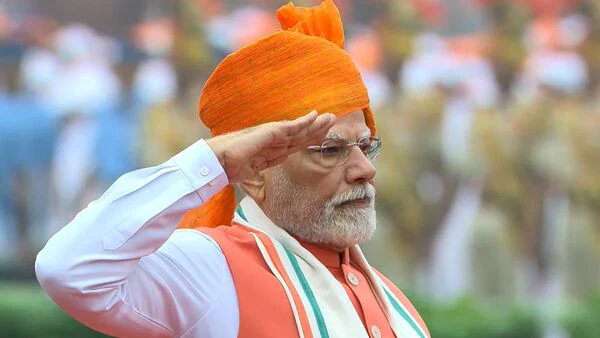On August 15, 2025, Prime Minister Narendra Modi delivered his 12th Independence Day address from the historic Red Fort, marking India’s 79th Independence Day. Speaking for over 100 minutes, PM Modi laid out a sweeping vision for a self-reliant, developed India (Viksit Bharat) by 2047, backed by a raft of major policy announcements, reforms, and initiatives spanning defence, technology, economy, governance, and social empowerment.
Who Spoke?
Prime Minister Narendra Modi, leading the nation since 2014, addressed citizens from the Red Fort ramparts, continuing the tradition started by Jawaharlal Nehru in 1947.
What Was the Message?
The central theme was Atmanirbhar Bharat self-reliance in critical sectors as the bedrock for national strength and dignity. PM Modi declared India must chart its own destiny, aiming to become a developed nation by 100 years of independence in 2047.
Key Announcements and Highlights
1. Defence & Strategic Autonomy
- Operation Sindoor was hailed as a testament to India’s ability to act independently and decisively against threats.
- Mission Sudarshan Chakra launched to neutralise enemy infiltrations and boost offensive defence capabilities, inspired by Lord Krishna’s legendary weapon.
- Call for Made-in-India jet engines, urging scientists and youth to accept the challenge, just as India developed indigenous vaccines during COVID-19.
2. Technology & Industrial Leadership
- First Made-in-India semiconductor chip to be rolled out by the end of 2025, reversing decades of missed opportunities.
- Over 300 space-tech startups now innovating in satellites and exploration, with plans for an Indian space station.
- Push for indigenous digital platforms, including social media, to ensure India’s data and communication sovereignty.
3. Energy Independence
- Goal of 50% clean energy by 2030 met five years early, in 2025.
- Ten new nuclear reactors operational, with plans to increase nuclear capacity tenfold by 2047.
- National Deepwater Exploration Mission launched to harness ocean resources for oil, gas, and energy security.
- National Critical Minerals Mission to secure strategic minerals across 1,200 exploration sites.
4. Economic Reforms & Jobs
- ₹1 lakh crore PM Viksit Bharat Rozgar Yojana to provide ₹15,000/month to newly employed youth and incentives to companies, targeting 3 crore jobs.
- Next-Generation GST reforms to be introduced by Diwali 2025, lowering taxes on essential goods and easing burdens on MSMEs.
- Creation of a Reform Task Force to modernise governance, reduce red tape, and prepare for a $10 trillion economy.
5. Governance & Law Simplification
- Over 40,000 compliances abolished and 1,500 outdated laws repealed in the past decade.
- Zero income tax for earnings up to ₹12 lakh per year.
- Replacement of outdated criminal codes with the Indian Justice Code for faster, simpler legal processes.
6. Agriculture & Farmers’ Welfare
- Push for domestic fertiliser production to protect farmers from global market shocks.
- Emphasis on Vocal for Local, urging shopkeepers to display “Swadeshi” boards and citizens to prefer Indian-made products.
7. Healthcare & Pharma Innovation
- Call to strengthen India’s role as the “pharmacy of the world” by developing new medicines and vaccines domestically.
- Appeal for patents and innovations in pharmaceuticals to make India a global hub for medical self-reliance.
When Will These Happen?
- Semiconductor chip rollout — by December 2025.
- GST reforms — Diwali 2025.
- Tenfold nuclear expansion — by 2047.
- PM Viksit Bharat Rozgar Yojana — immediate rollout in 2025.
Where Does It Matter Most?
- Border areas — High-Powered Demography Mission to combat illegal infiltration.
- Technology hubs — semiconductors, AI, deep-tech industries.
- Rural/agricultural regions — fertiliser self-reliance, farmer welfare.
- Strategic defence & energy zones — nuclear sites, deepwater exploration areas.
Why This Speech Stands Out
This was PM Modi’s longest Independence Day address, blending policy announcements with nationalistic pride. Unlike purely symbolic speeches, it was filled with concrete targets, financial commitments, and sector-specific roadmaps. It also signalled India’s shift from being a global participant to a global leader, particularly in defence technology, clean energy, and digital sovereignty.
How It Will Affect Citizens
- Lower taxes and simpler compliance for individuals and businesses.
- More job opportunities for fresh graduates and skilled youth.
- Stronger national security through indigenous defence production.
- Better access to affordable medicines and healthcare innovations.
- Energy stability with clean, domestic sources reducing fuel price shocks.
- Empowered digital space with Indian-owned social media and platforms.
Conclusion
PM Modi’s 2025 Independence Day address was as much a policy blueprint as a patriotic speech. By linking cultural heritage (like the Sudarshan Chakra) with cutting-edge innovation (like semiconductors and AI), the Prime Minister projected a vision where India’s growth is rooted in self-reliance, driven by technology, and sustained by inclusive economic reforms. If implemented effectively, the initiatives announced could significantly reshape India’s economic, defence, and social landscape before its centenary in 2047.



